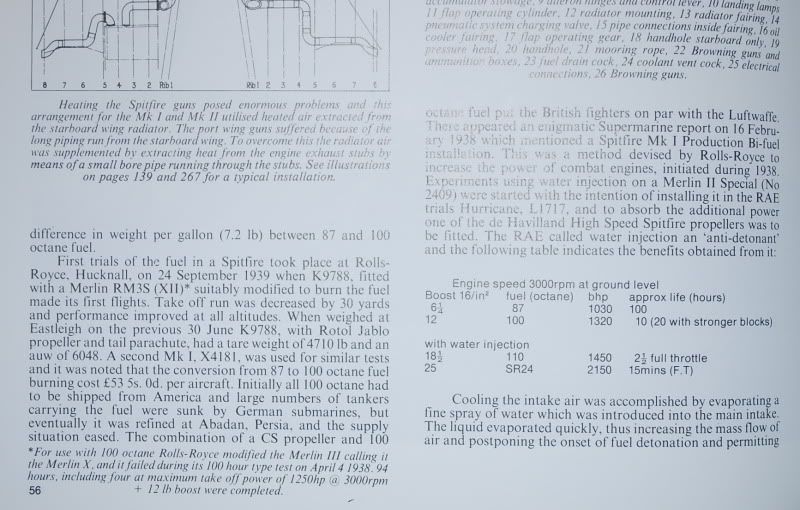Quote:
Originally Posted by Crumpp

There is no weak case.
There is quite a bit of raw speculation that attempts to bedazzle folks into thinking a specific way...
Morgan and Shacklady say something completely different which also fits the information in the document you posted on weekly issues.
That is the RAF built up a strategic reserve and it was not until September 1940 that 16 squadrons from Fighter Command converted to 100 octane.
Not only do I think Morgan and Shacklady's research was more through and grounded than yours, it is a fact that every military required such a reserve.
 |
The only one suffering from wishful thinking, raw speculation and presenting no case at all, let alone a weak one, is someone who places so much faith in the "well grounded" research of M & S...someone like Crumpp, who has not provided a single scrap of evidence to prove anything throughout this entire thread, apart from parroting what others have said.
From the NA:
cab68/6/11 "War Cabinet Oil Position: Thirty-third Weekly Report: 23 April 1940" (
http://www.nationalarchives.gov.uk/r...-1939-1945.htm Scroll down to
4.Cabinet Papers or Memoranda, click on
cab68; enter reference no. "cab68/6/11" in this format in top l/h corner of new page, click on "Go to reference"; click on "View digital image" then "+Add to shopping"; it is free and downloadable)
"The process of bringing Norwegian tankers under Allied control has advanced during the week, and of a total fleet of 212 Norwegian tankers 119 are now under Allied control, while 18 are proceeding to Allied ports; 93 are in neutral ports or reported to be proceeding to neutral ports..."
Meaning in April 1940 Britain had already gained the use of 119 Norwegian tankers, 41 more than were sunk between Sept 1939 and November 1940, and more were expected.
cab68/7/31 "War Cabinet Oil Position Monthly Report: November 1940" (issued 20 December) (
http://www.nationalarchives.gov.uk/r...-1939-1945.htm)
Table I: "Imports Into the United Kingdom (Services and Civil)"
Shows the total number of tankers arriving in UK ports in the year between September 1939 and August 1940 =
947: (Total shown in table = 1,079 minus 132, June to August 1939.)
March to May 1940 = 109 tankers; 1,112,300 tons imported;
June to August = 100 tankers; 1,058,900 tons
total tonnage of oil products imported = 9,986,900. (11,126,900 minus 1,140,000 tons, imported June to August 1939.): an average of 10,546 tons per tanker.
September and October 1940: 124 tankers (62 per month) arrived and in November 80: September = 640,500 tons of imports; October = 651,600; November = 890,300 tons
Grand Total of Tankers arriving in UK Sept 1939 to November 1940 = 1,151
Grand Total of Oil Products Imported = 12,169,300 tons: 10,573 tons of oil product per tanker
Total number sunk Sept 1939 - Nov 1940 = 78(!!); 385,957 tons of oil product = roughly 6.8% tankers; roughly 3.2% of tons imported to Britain. The amount of oil product per tanker destroyed was 4,948 tons, meaning on average the tankers sunk were carrying less than half the weight of cargo each tanker that arrived in port was discharging; the tankers being sunk were either smaller than average, or, more likely, at least half of them were sunk in ballast.
Explains why fuel stocks continued to rise right throughout the B of B, and shows that Morgan and Shacklady were right in that tankers were sunk; problem is that the numbers were paltry compared with the numbers arriving in Britain and unloading their cargo. Nor is there any cross referencing used by M & S providing sources for their claim that large numbers of tankers carrying 100 octane were sunk.

Cabinet papers, which can be downloaded and examined for free as opposed to unreferenced speculation by Morgan et al.
No Crumpp,
you provide some documentary evidence that frontline fighter units of FC were using 87 octane fuel during combat operations during the B of B
Crumpp;
You provide some documentary evidence that the RAF stuck to its pre-war plans to have 800,000 tons of 100 octane fuel before releasing it to FC.
Crumpp;
You provide documentary evidence that the RAF considered that stocks of 100 octane fuel were too low to supply more than the 16 front line fighter squadrons of FC and two Blenheim units that you and others allege.
Crumpp;
You provide documentary evidence that so many tankers carrying 100 octane fuel were sunk that somehow there was never enough to go round.
Quote:
Originally Posted by Crumpp

There is nothing intelligent to discuss about it until a fuel specification order or something saying all units are to use it is found. All that can be said as a fact is the RAF transitioned from 87 Octane to 100 Octane by early 1941.
|
Oh, do you mean the attached document dated 7 August stating that
All operational aircraft have been authorised to use 100 Octane, and that instructions have been issued to Commands?
Quote:
Originally Posted by Crumpp

I am out of this debate at this point.
|
And yet here you are, re-entering with nothing fresh or useful to say.
